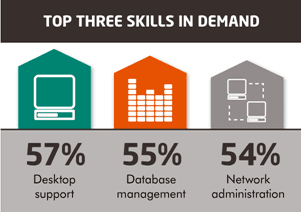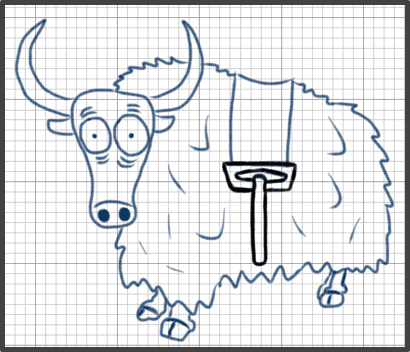There are many lamentations in the tech industry regarding the “skill gap” in security. That’s the inability of organizations to find talented security professionals to fill increasingly critical positions across every vertical industry.
But less is mentioned about the skill gap in other technology-related disciplines, like the network.
Robert Half Technology, who tracks salaries and skills across IT, recently released its 2016 surveys in which it found that there appears to be growing competition for “network” folk in the land.

According to its first 2016 report, “network administration” is one of the top three skills in demand right now with 54% of CIOs surveyed noted a need for network talent.
That’s no surprise, or at least it shouldn’t be. More apps means more servers and more users. More servers and users means more network. And more network means more network administrators needed to provision, monitor, manage, and troubleshoot all the various things that can (and do) go wrong in the course of delivering apps.
Productivity and profit today ride on fast, reliable networks. That means not just the routing and switching but the distribution (load balancing) and performance enhancing (caching and TCP multiplexing) services apps need to zip back and forth between user and app, whether corporate or consumer.
But those services and networks need people. They need people who understand how to architect a network, how to apply policies in the right places, how to determine what service can most effectively solve a given problem, whether scale or security or speed.
Those people are apparently in short supply. Which is why operational scale is imperative for CIOs who know they need more network talent available. By providing the tools to automate and orchestrate much of the yak shaving* that occurs just as frequently in networkers lives as it does developers, CIOs can scale their valuable (and limited) networking professionals. Reducing the amount of time required to spend on “tedious” tasks has the side benefit of not just improving their productivity, but their satisfaction with their roles. That has the potential to reduce networker churn, which is as costly to IT organizations as it is to any industry in which time and money must be spent training and educating new hires.
A CAP study found average costs to replace a mid-range ($30k – $50k) position is 20% of their annual salary. For example, the cost to replace a $40k manager would be $8,000. That same study averaged out “highly skilled” positions (excluded physicians and executives) and found the replacement cost was negligibly higher at 20.7%. Regardless, we all know that IT positions in certain segments are outside the “mid-range” salary. Figure 20% of their salary to replace them and a hit on productivity while they “get up to speed” on the environment.

So it’s not just a matter of CIOs struggling to hire new talent for networking positions, it's also a matter of figuring out how retain (and scale) those they already employ. Eliminating tedious, yak-shaking tasks and providing more time for the innovation (and to adapt and design the networks needed to support emerging app architectures like microservices and containerization) is critical to addressing the skill gap.
CIOs need to embrace automation and orchestration (call it DevOps, call it SDx, call it late for dinner, just don’t call it missing from your strategic plans) as a means to not only improve the business’ ability to quickly deliver new apps (or new versions of apps) to the market and support cloud (both on-premise and off) but to address the challenges of scaling the network in the face of high demand for a limited pool of talented networking professionals.
APIs, templates, and data center orchestration are key to addressing the need to scale out the networks faster and more frequently as well as the network engineers you have without burning them out.
That’s important, because it turns out the grass really might be greener on the other side fence without all those yaks trampling on it while they wait to be shaved.
*Yak shaving, for the uninitiated, has several related definitions the most concise of which are tasks that must be completed in order to do your job. Most common example is developers who need to configure, launch, and troubleshoot a web server in order to test the code they just completed. In the network, this might be the need to configure and troubleshoot a new network segment in order to deploy more advanced networking services like load balancing, app security, and performance-related services.
About the Author

Related Blog Posts

Nutanix and F5 expand successful partnership to Kubernetes
Nutanix and F5 have a shared vision of simplifying IT management. The two are joining forces for a Kubernetes service that is backed by F5 NGINX Plus.

AppViewX + F5: Automating and orchestrating app delivery
As an F5 ADSP Select partner, AppViewX works with F5 to deliver a centralized orchestration solution to manage app services across distributed environments.

Build a quantum-safe backbone for AI with F5 and NetApp
By deploying F5 and NetApp solutions, enterprises can meet the demands of AI workloads, while preparing for a quantum future.

F5 ADSP Partner Program streamlines adoption of F5 platform
The new F5 ADSP Partner Program creates a dynamic ecosystem that drives growth and success for our partners and customers.
F5 NGINX Gateway Fabric is a certified solution for Red Hat OpenShift
F5 collaborates with Red Hat to deliver a solution that combines the high-performance app delivery of F5 NGINX with Red Hat OpenShift’s enterprise Kubernetes capabilities.
Phishing Attacks Soar 220% During COVID-19 Peak as Cybercriminal Opportunism Intensifies
David Warburton, author of the F5 Labs 2020 Phishing and Fraud Report, describes how fraudsters are adapting to the pandemic and maps out the trends ahead in this video, with summary comments.
